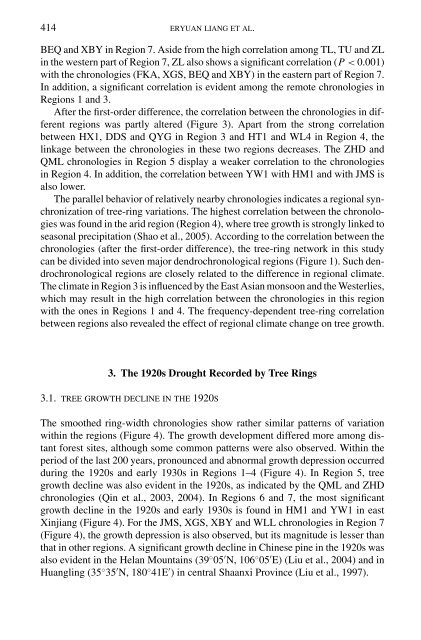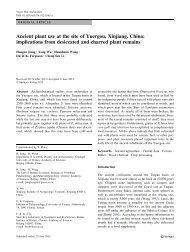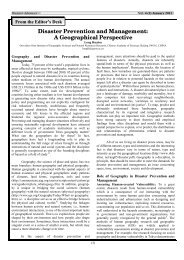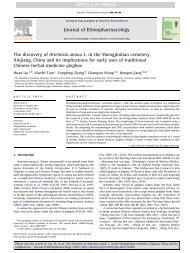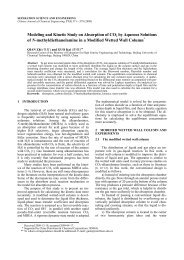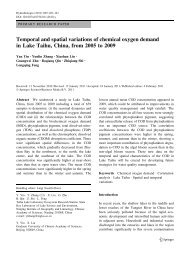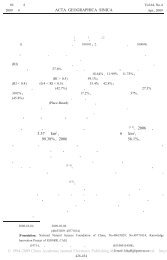THE 1920S DROUGHT RECORDED BY TREE RINGS AND ...
THE 1920S DROUGHT RECORDED BY TREE RINGS AND ...
THE 1920S DROUGHT RECORDED BY TREE RINGS AND ...
You also want an ePaper? Increase the reach of your titles
YUMPU automatically turns print PDFs into web optimized ePapers that Google loves.
414 ERYUAN LIANG ET AL.BEQ and X<strong>BY</strong> in Region 7. Aside from the high correlation among TL, TU and ZLin the western part of Region 7, ZL also shows a significant correlation (P < 0.001)with the chronologies (FKA, XGS, BEQ and X<strong>BY</strong>) in the eastern part of Region 7.In addition, a significant correlation is evident among the remote chronologies inRegions 1 and 3.After the first-order difference, the correlation between the chronologies in differentregions was partly altered (Figure 3). Apart from the strong correlationbetween HX1, DDS and QYG in Region 3 and HT1 and WL4 in Region 4, thelinkage between the chronologies in these two regions decreases. The ZHD andQML chronologies in Region 5 display a weaker correlation to the chronologiesin Region 4. In addition, the correlation between YW1 with HM1 and with JMS isalso lower.The parallel behavior of relatively nearby chronologies indicates a regional synchronizationof tree-ring variations. The highest correlation between the chronologieswas found in the arid region (Region 4), where tree growth is strongly linked toseasonal precipitation (Shao et al., 2005). According to the correlation between thechronologies (after the first-order difference), the tree-ring network in this studycan be divided into seven major dendrochronological regions (Figure 1). Such dendrochronologicalregions are closely related to the difference in regional climate.The climate in Region 3 is influenced by the East Asian monsoon and the Westerlies,which may result in the high correlation between the chronologies in this regionwith the ones in Regions 1 and 4. The frequency-dependent tree-ring correlationbetween regions also revealed the effect of regional climate change on tree growth.3. The 1920s Drought Recorded by Tree Rings3.1. <strong>TREE</strong> GROWTH DECLINE IN <strong>THE</strong> <strong>1920S</strong>The smoothed ring-width chronologies show rather similar patterns of variationwithin the regions (Figure 4). The growth development differed more among distantforest sites, although some common patterns were also observed. Within theperiod of the last 200 years, pronounced and abnormal growth depression occurredduring the 1920s and early 1930s in Regions 1–4 (Figure 4). In Region 5, treegrowth decline was also evident in the 1920s, as indicated by the QML and ZHDchronologies (Qin et al., 2003, 2004). In Regions 6 and 7, the most significantgrowth decline in the 1920s and early 1930s is found in HM1 and YW1 in eastXinjiang (Figure 4). For the JMS, XGS, X<strong>BY</strong> and WLL chronologies in Region 7(Figure 4), the growth depression is also observed, but its magnitude is lesser thanthat in other regions. A significant growth decline in Chinese pine in the 1920s wasalso evident in the Helan Mountains (39 ◦ 05 ′ N, 106 ◦ 05 ′ E) (Liu et al., 2004) and inHuangling (35 ◦ 35 ′ N, 180 ◦ 41E ′ ) in central Shaanxi Province (Liu et al., 1997).


